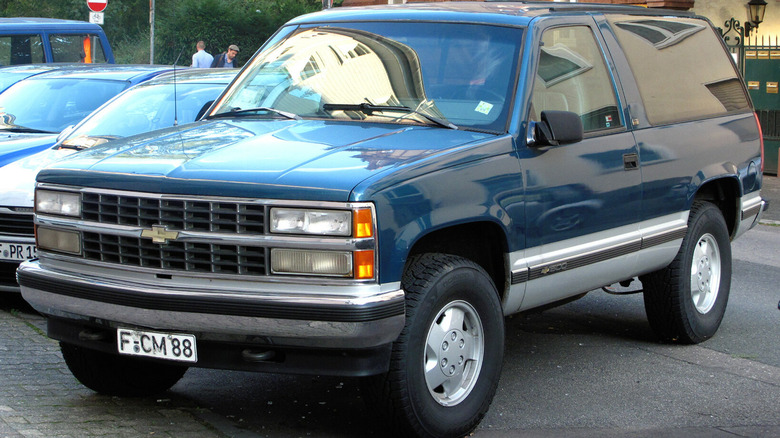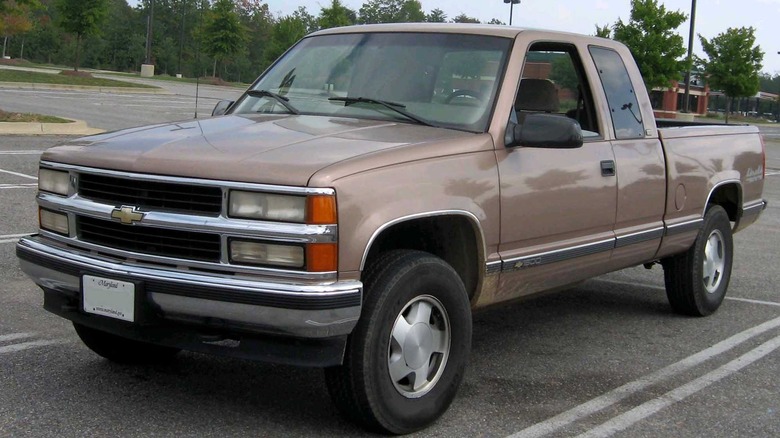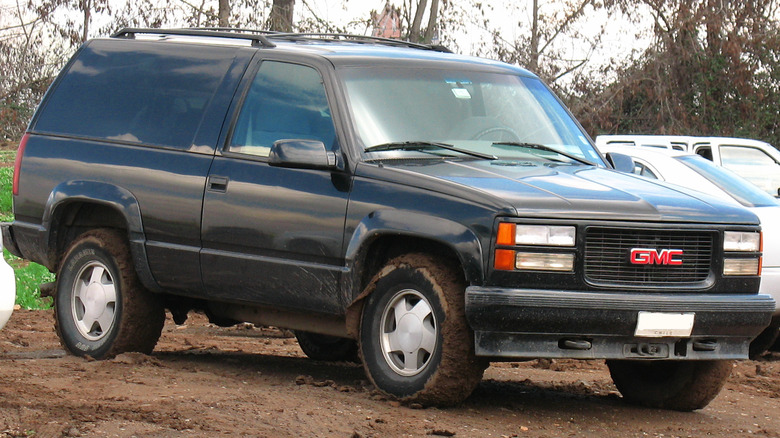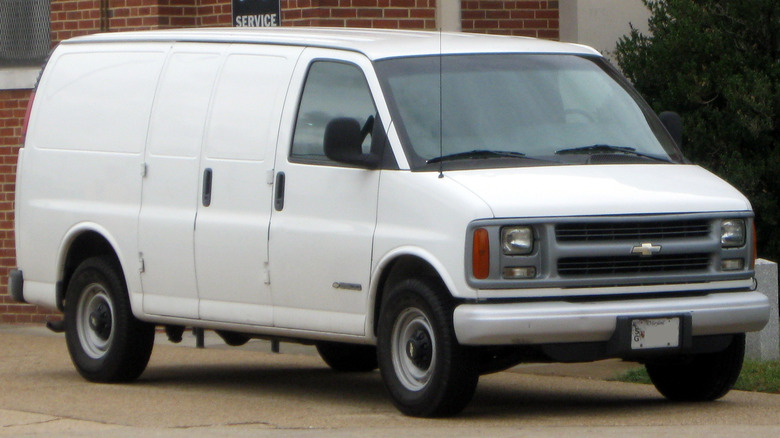
Rutger van der Maar /Wikimedia
Many car companies in the United States have been scaling back on their diesel engine offerings over the last few years. This includes the ceasing of production of the EcoDiesel engines that had been used in various Jeep and Ram truck models. As electric vehicles become more of a priority, the market for diesel fuel becomes less prominent — and it was already a niche market to begin with. However, diesel is not completely dead in America, and the Duramax engines from General Motors that have remained in production since 2001 are proof of that. Prior to GM introducing Duramax, its V8 diesel engines were instead produced by the Detroit Diesel Corporation for 20 years.
For the first decade of this run, it produced a 6.2-liter diesel V8, but in 1992, that was replaced by the even larger 6.5-liter V8 model. This particular engine had a great many uses for General Motors, but its attention was bifurcated, as it had a standard edition and a turbocharged version. That standard, naturally aspirated version was made for truly large vehicles like the Hummer H1 and the HMMWV military vehicles. Meanwhile, the turbocharged 6.5-liter Detroit Diesel V8 was something you were far more likely to see in a vehicle in your day-to-day life on the road. Let’s spotlight all of the various GM vehicles that this particular engine powered over its decade in production.
[Featured image by Rutger van der Maar via Wikimedia Commons | Cropped and scaled | CC BY 2.0]
Diesel for trucks of all sizes

IFCAR/Wikimedia
As you might expect with American diesel, the initial implementation of this new turbocharged 6.5-liter diesel V8 engine from General Motors was with the company’s pickup trucks. At first, it was only in some of the heavy-duty trucks the company produced those first couple of years. The 6.5-liter V8 made its debut in the 1992 model year for Chevrolet and GMC C/K pickup trucks, which we have now come to know as the Silverado and Sierra. That year, the turbocharged engine was an option for both the 2500 and 3500 models of those trucks, though it was still offered alongside the previous 6.2-liter model as well.
For two years, these trucks were the only way you get your hands on the 6.5-liter model, but GM began to expand its usage further in 1994. That included putting it under the hood of even more pickup trucks, which saw the lighter-weight 1500 models of the Chevrolet and GMC C/K trucks get this diesel option.
One of the primary reasons many people opt for diesel over gasoline is because it’s a more efficient fuel, and that proved true with these pickups. If you were to get the larger gasoline-powered engine with 5.7 liters of displacement, you would be getting a combined fuel economy of about 13 mpg. Meanwhile, the turbocharged 6.5-liter diesel V8 got about 17 mpg instead. For being the only difference in the vehicles, that is an impressive improvement.
[Featured image by IFCAR via Wikimedia Commons | Cropped and scaled | Public Domain]
The diesel-powered SUVs

order_242/Wikimedia
When General Motors opted to start putting this new diesel engine in its 1500 model pickup trucks, it also decided that the engine could be useful in other vehicles as well. This expansion was primarily for the company’s SUVs. Not only did this include an SUV that had already been using the 6.2-liter version as an option, but this also covered vehicles getting these Detroit Diesel V8s for the first time.
The vehicle that was upgraded to the 6.5-liter engine from the 6.2-liter version was the Chevrolet Suburban, a name also shared by its GMC counterpart before it was changed to the Yukon XL that we know today. Over in Australia, this Suburban name was used by the Holden company, which also offered this diesel-powered V8. Like with the C/K trucks initially, the Suburban only had diesel as an option for the heavier-duty models like the 2500.
General Motors didn’t stop there with its full-size SUVs either, and it made the turbocharged engine an option for the Chevrolet Blazer and GMC Yukon as well. These were still full-size SUVs, though not quite as large as the Suburbans. After one year, Chevrolet decided to rebrand the Blazer to the Tahoe, a name that has remained until today. With these, there was no barrier to entry, and it was available with the standard 1500 model as an option for buyers. The fuel economy results were almost as beneficial as with the trucks, as a Chevy Blazer could get 15 mpg with the 6.5-liter V8 rather than 12 mpg with the standard 5.7L-liter engine.
[Featured image by order_242 via Wikimedia Commons | Cropped and scaled | CC BY-SA 2.0]
Large vans can be turbocharged too

IFCAR/Wikimedia
The last vehicle that received the turbocharged 6.5-liter diesel engine — the Chevrolet Express/GMC Savana — would not actually have it as an option until 1996, but in the end, it used that engine for a longer time than any other vehicle mentioned here. The reason why it didn’t receive the V8 in 1992 or 1994 like the other vehicles was because it didn’t exist until 1996. The 6.5-liter diesel would be exclusive to the heavier-duty 2500 and 3500 models of the van and would remain that way until the end.
The Express and Savana vans would actually use the Detroit Diesel engine through the 2002 model year, with nearly every other usage of the 6.5-liter V8 would cease around 1999 or 2000. This was the same time that General Motors was discontinuing these engines in favor of producing the Duramax diesel engines as a replacement. However, these vans would not get replaced immediately and would go without a diesel option until 2006 before the Duramax engine was finally an option.
With the turbocharged 6.5-liter diesel V8 under the hood, the Express and Savana vans could generate 190 hp and 385 lb-ft. of torque. That was a significant power upgrade compared to the two companies’ previous vans that the Express and Savana replaced.
[Featured image by IFCAR via Wikimedia Commons | Cropped and scaled | Public Domain]